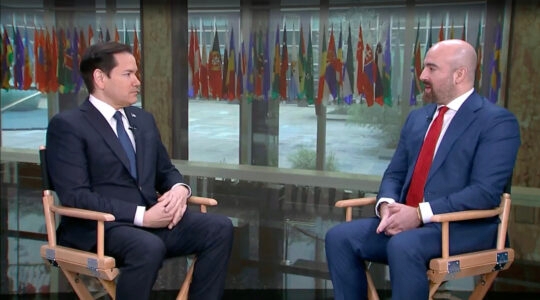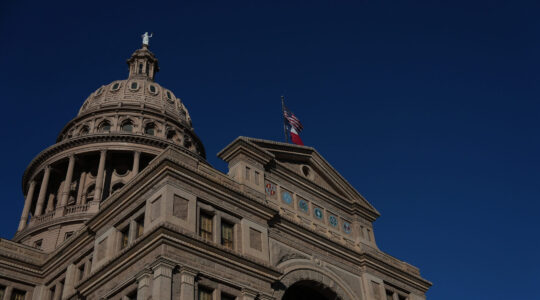NEW YORK (JTA) — The release of a highly anticipated ombudsman’s report about how the Claims Conference missed an opportunity in 2001 to detect a massive fraud scheme is raising serious questions about governance of the organization and pitting the organization’s chief executive against the chairman of its executive committee.
The report, which calls for changes to the structure, administration and management of the Claims Conference, also has divided the committee tasked with producing it. On Sunday, two of the four committee members disavowed the report and resigned.
The report was commissioned following the disclosure that an anonymous letter received by the organization’s Frankfurt office in 2001 provided a chance to detect a massive fraud scheme that would run for another eight years and ultimately result in $57 million in fraudulent restitution payouts from 1993 to 2009.

Claims Conference representatives Roman Kent, Stuart Eizenstat and Greg Schneider visit Yad Vashem during the organization’s negotiating session with Germany in May 2013. (Claims Conference)
The disclosure prompted calls for an independent investigation of the Claims Conference, including from leaders of organizations represented on its board. It also led to calls for the resignation of Julius Berman, the Claims Conference chairman (and a JTA board member), who oversaw one of the two failed probes into the allegations contained in the anonymous letter.
In response, Berman tasked a “select leadership committee” led by Reuven Merhav, chairman of the Claims Conference’s executive committee, to handle the matter. Following its first meeting in early June, Merhav’s four-man panel asked the Claims Conference ombudsman, Shmuel Hollander, to investigate.
The committee’s report was first made public and posted online by the Forward on Monday, a day before the Claims Conference’s annual board meeting in New York. (The president of the Forward Association sits on the Claims Conference board.)
“Best practice and competence, were missing in respect of this matter,” the report said of the 2001 episode. There is a “real need for improvements in the Claims Conference’s administration, management and governance, generally.”
On Sunday, committee members Abraham Biderman and Roman Kent sent letters to the board saying the report contains factual errors and does not take into account management changes made since 2001. In addition, the chief executive at the Claims Conference, Greg Schneider, sent the board a lengthy rebuttal in which he called the report “deeply flawed.”
The remaining two members of the leadership committee, Merhav and Robert Goot, stand by the report.
The anonymous letter came to light during the trial two months ago of Semen Domnitser, a Claims Conference employee who oversaw the two major restitution programs in which the fraud occurred — the Article 2 Fund and the Hardship Fund. In all, 31 people were arrested in connection with the scheme; all pleaded guilty or have been found guilty.
The report blames a “litany of lack of diligence, competence and judgment” among senior Claims Conference leaders for failing to follow up on the 2001 letter suggesting that Domnitser was engaged in foul play. But the report singles out no individual for special opprobrium and says there is no evidence that anyone at the Claims Conference tried to cover up the bungled reviews in 2001 of the anonymous letter’s allegations.
In fact, it was the Claims Conference that unearthed correspondence in Frankfurt about the 2001 letter and turned it over to the FBI after discovering the fraud and alerting the FBI to it in 2009.
In his rebuttal, Schneider is clear about who he believes is responsible: Karl Brozik, the director of the Claims Conference’s Frankfurt office, which received the anonymous letter describing five problematic cases handled by Domnitser. Again and again in his 21-page rebuttal, Schneider points to mistakes made by Brozik, who died in 2004.
But the report says Brozik does not deserve blame for the “Letter affair.”
“We find it impossible to accept this version of events, and believe it to be without any basis in reality,” the committee wrote.
After receiving the letter, Brozik queried Domnitser on the questionable cases. Among those copied on some of the correspondence between Brozik, who was in Frankfurt, and Domnitser, who was in New York, were Gideon Taylor, then the chief executive of the conference, and Schneider, then an assistance executive vice president. The paper trail appears to end with a review of Domnitser’s responses by a staffer in Brozik’s office who raised further questions for investigation that were never acted upon.
The New York office also conducted its own probe when Taylor asked Berman, who at the time was a pro bono counsel to the Claims Conference, to look into the matter. Berman assigned the job to a paralegal at his law firm, Kaye Scholer, who questioned Domnitser and prepared a report that recommended further investigation. Berman delivered the report to Taylor on Sept. 5, 2001.
The ombudsman’s report notes the failure to follow up on either of the 2001 probes, concluding that they “should, at the very least, have served as an alert to Mr. Domnitser’s superiors” — but there was no one “functioning in this capacity.”
The report said the “absence of professional control systems, as well as the absence of computerization,” were key factors in enabling and facilitating the fraud.
In one of the report’s most damning findings, the ombudsman found that the bungled questioning of Domnitser about the anonymous accusations didn’t just fail to detect his fraud but may have even encouraged him to expand his scheme.
“Mr. Domnister’s unmonitored control of the system under his management, and the absence of real supervision, enabled him to neutralize any attempt to investigate the detailed claims raised in the Letter,” the report said. “Indeed, in practice this process only seems to have reinforced his belief that his actions would remain undiscovered.”
JTA has documented Jewish history in real-time for over a century. Keep our journalism strong by joining us in supporting independent, award-winning reporting.





